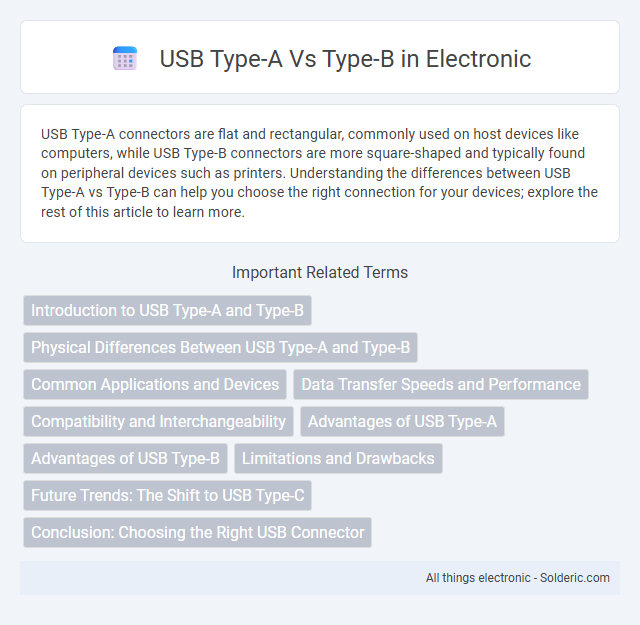USB Type-A connectors are flat and rectangular, commonly used on host devices like computers, while USB Type-B connectors are more square-shaped and typically found on peripheral devices such as printers. Understanding the differences between USB Type-A vs Type-B can help you choose the right connection for your devices; explore the rest of this article to learn more.
Comparison Table
| Feature | USB Type-A | USB Type-B |
|---|---|---|
| Shape | Flat, rectangular | Square with beveled exterior corners |
| Common Use | Host devices (computers, hubs) | Peripheral devices (printers, scanners) |
| Connector Orientation | One correct way to plug in | One correct way to plug in |
| Data Transfer | Supports USB 1.1, 2.0, 3.0, and higher | Supports USB 1.1, 2.0, 3.0, and higher |
| Power Delivery | Up to 100W via USB PD | Up to 100W via USB PD |
| Backward Compatibility | Yes | Yes |
| Typical Devices | Laptops, desktops, flash drives | Printers, external drives, audio interfaces |
Introduction to USB Type-A and Type-B
USB Type-A connectors, characterized by their flat and rectangular shape, serve as the standard interface commonly found on host devices like computers and power adapters. USB Type-B connectors, typically square with beveled exterior corners, are designed primarily for peripheral devices such as printers and external hard drives. Both connector types support various USB standards including USB 2.0, USB 3.0, and USB 3.1, facilitating data transfer and power delivery between devices.
Physical Differences Between USB Type-A and Type-B
USB Type-A connectors feature a flat, rectangular shape designed for host devices like computers, while USB Type-B connectors are typically square with beveled edges, tailored for peripheral devices such as printers. The physical design of Type-A ensures a one-way connection for data flow, whereas Type-B's shape prevents incorrect insertion on devices. Understanding these distinct designs helps you correctly connect your devices and avoid damage from incompatible ports.
Common Applications and Devices
USB Type-A connectors are predominantly used in computers, TVs, and game consoles to connect peripherals like keyboards, mice, and flash drives. USB Type-B connectors are commonly found in printers, scanners, and external hard drives, facilitating device-to-host communication. Understanding these differences helps you choose the right cable for your devices, ensuring compatibility and optimal performance.
Data Transfer Speeds and Performance
USB Type-A connectors typically support data transfer speeds ranging from USB 1.1's 12 Mbps up to USB 3.2 Gen 2's 10 Gbps, depending on the USB version implemented. USB Type-B connectors, commonly used for peripheral devices like printers and external drives, also support similar speed ranges but are often found in USB 2.0 (480 Mbps) and USB 3.0/3.1 (up to 5 Gbps) variants. Performance differences mainly arise from the USB generation rather than the connector type, with USB 3.x versions offering significantly higher throughput and improved power delivery compared to USB 2.0.
Compatibility and Interchangeability
USB Type-A connectors are widely compatible with most computers, laptops, and chargers, making them the standard choice for host devices, while USB Type-B connectors are primarily used for peripheral devices like printers and external hard drives, limiting their interchangeability. Type-A ports typically serve as power sources and data transmitters, whereas Type-B ports are designed to receive power and data, preventing direct interchange without adapter cables. Universal compatibility between the two requires specific cables or adapters that bridge the physical and functional differences between USB Type-A and Type-B connectors.
Advantages of USB Type-A
USB Type-A connectors offer widespread compatibility with a vast range of devices including computers, peripherals, and charging adapters, making them the most versatile USB interface. Their flat and rectangular design enables easy and secure connections, reducing the risk of damage from improper insertion. The robust construction of USB Type-A ports supports higher durability and longer lifespan compared to alternative USB connector types.
Advantages of USB Type-B
USB Type-B connectors provide secure and durable connections, making them ideal for devices like printers and external hard drives that require stable data transfer. Their square shape minimizes accidental disconnections and enhances compatibility with various professional peripherals. You benefit from reliable performance and easy device identification when using USB Type-B ports in your setup.
Limitations and Drawbacks
USB Type-A connectors are limited by their flat, asymmetrical design, which restricts insertion orientation and increases wear from repeated use. Type-B connectors, often bulkier, pose challenges in compact device integration and are less common in modern consumer electronics, reducing compatibility options. Your choice between the two may impact ease of connection and future-proofing, especially as USB-C continues to dominate newer devices.
Future Trends: The Shift to USB Type-C
USB Type-C is rapidly becoming the universal standard, offering faster data transfer speeds up to 40 Gbps with Thunderbolt 3 and improved power delivery up to 100W compared to USB Type-A and Type-B. This shift enhances compatibility across devices, including smartphones, laptops, and peripherals, simplifying connectivity with a reversible design. Your future tech setups will benefit from USB Type-C's versatility, supporting video output, charging, and data simultaneously.
Conclusion: Choosing the Right USB Connector
Selecting the appropriate USB connector depends on your device compatibility and data transfer needs. USB Type-A is commonly used for host devices like computers, offering universal connectivity and widespread support. USB Type-B connectors often serve peripheral devices such as printers, ensuring stable connections tailored to specific hardware requirements.
USB Type-A vs Type-B Infographic

 solderic.com
solderic.com